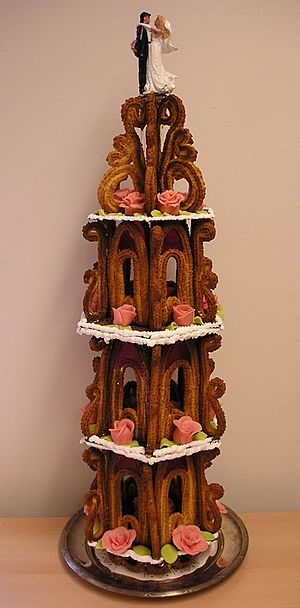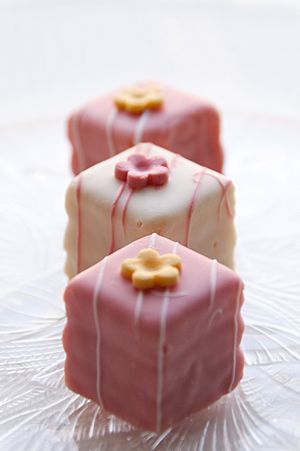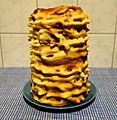Confectionery facts for kids
Confectionery is a fancy word for sweet foods, often called sweets or candy. These tasty treats are usually divided into two main groups: bakers' confections and sugar confections.
Bakers' confections are mostly sweet baked goods like cakes and pastries. In some parts of the world, especially the Middle East and Asia, these flour-based sweets are very popular.
Sugar confections include things like hard candies, chocolates, chewing gum, and other treats made mainly from sugar. Sometimes, chocolates are seen as their own group. You might hear these sweets called "candy" in the US, "sweets" in the UK, or "lollies" in Australia.
Confectionery has a long and interesting history, going back to ancient times. People have enjoyed sweet treats for thousands of years!
Contents
What's in Your Sweets?
Most confections are high in calories but don't have many important nutrients like vitamins or protein. They are often called "empty calories" because they give you energy but not much else that your body needs.
However, some special chocolates have been made for military use. These are designed to give soldiers a lot of energy in a small package.
Sweet Ingredients
The main thing that makes confections sweet is, well, sweeteners! Usually, this means sugar. The most common type is table sugar, which is a mix of glucose and fructose.
Sometimes, a special kind of sugar called invert sugar is used. It's even sweeter than regular sugar! Many commercial sweets also use different corn syrups, which are made from starch. You can also find sugar-free sweets, like sugar-free peppermints, which use other sweeteners instead of sugar.
Bakers' Confections
Bakers' confections are sweet foods that are usually baked and have flour as a main ingredient. They are often served as dessert.
Some popular types of baker's confections include:
Sugar Confections
Sugar confections are sweet, sugar-based foods that people usually eat as a snack.
This group includes many different treats, such as:
- Hard candies
- Chocolates
- Candied fruits and nuts
- Chewing gum
- Sometimes even ice cream
Different English-speaking countries have their own words for sugar confections:
- In Britain and Ireland, people often say sweets or sweeties.
- In Australia and New Zealand, they are called lollies.
- In North America, the word candy is most common.
Images for kids
-
Some Indian confectionery desserts from hundreds of varieties. In certain parts of India, these are called mithai or sweets. Sugar and desserts have a long history in India: by about 500 BCE, people in India had developed the technology to produce sugar crystals. In the local language, these crystals were called khanda (खण्ड), which is the source of the word candy.
-
Rock candy is simply sugar, with optional coloring or flavor.
-
A bar of chocolate. To be eaten pure, or used as an ingredient.
-
Brittles are a combination of nuts and caramelized sugar.
-
Welsh cakes are cooked on a griddle.
-
Korean rainbow rice cake is for celebrations.
-
European spit cakes are baked around a metal cylinder.
-
Empty shells made with puff pastry can be filled with fruit or cream.
-
Mooncake pastries are made to celebrate the Mid-Autumn Festival in East Asia.
-
Oliebollen and similar doughnuts are fried in hot fat.
-
Apple fritter with powdered sugar
-
A sweet rock cake
See also
 In Spanish: Repostería para niños
In Spanish: Repostería para niños


























